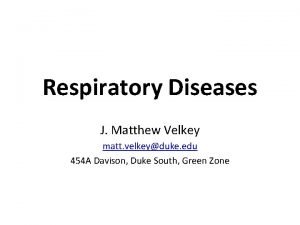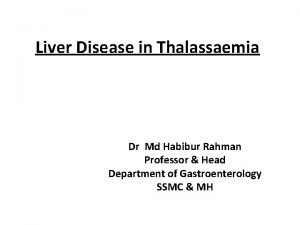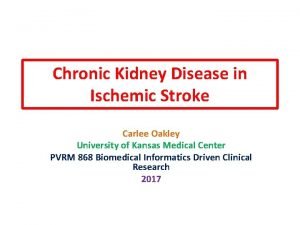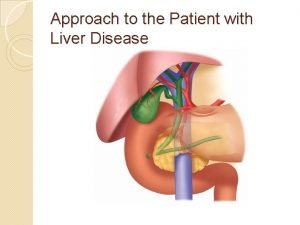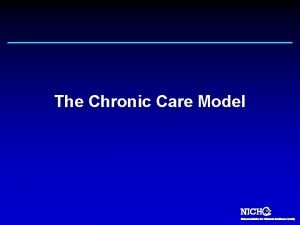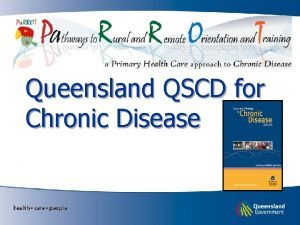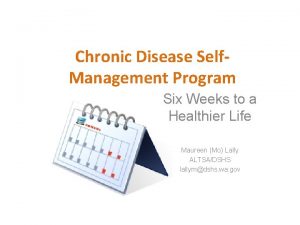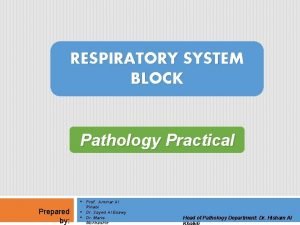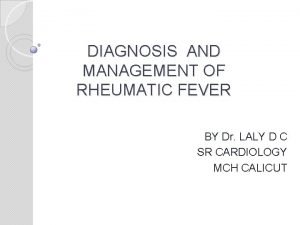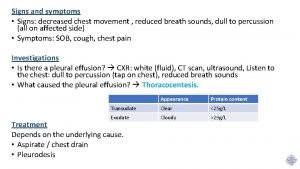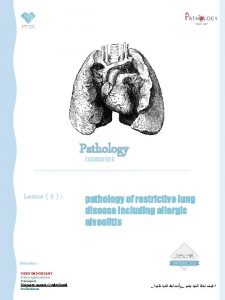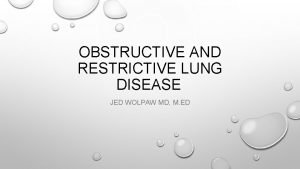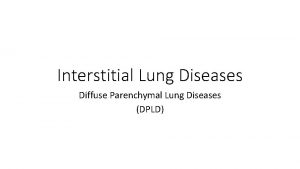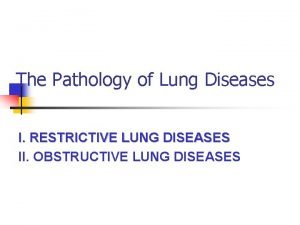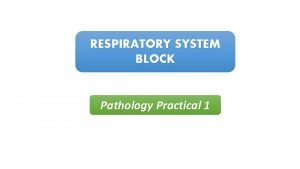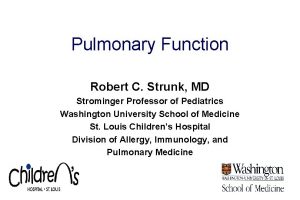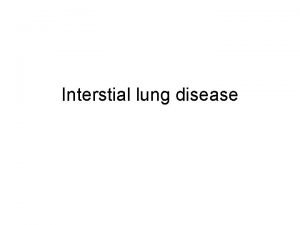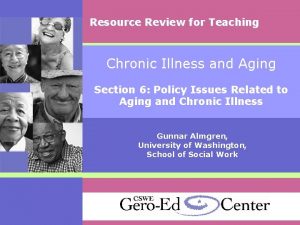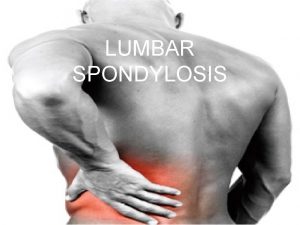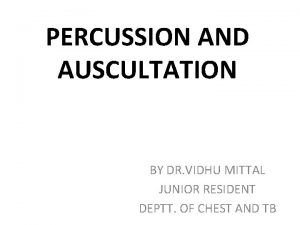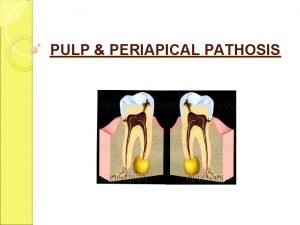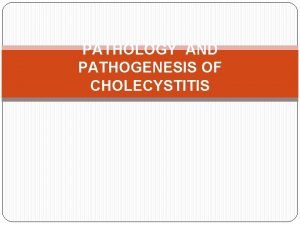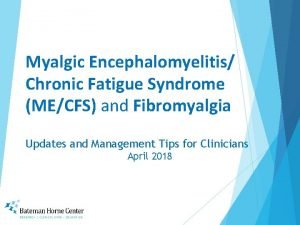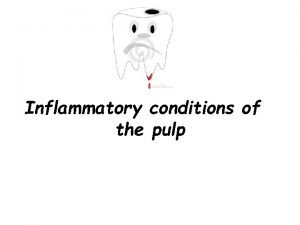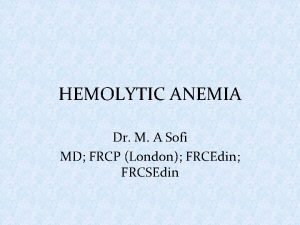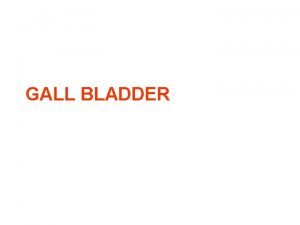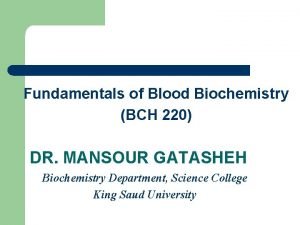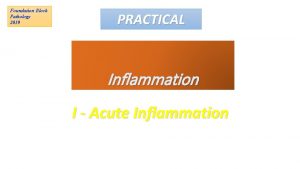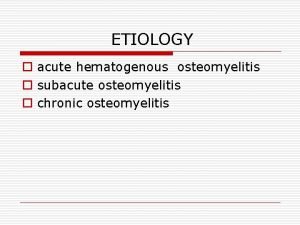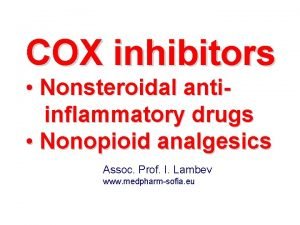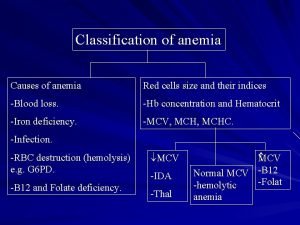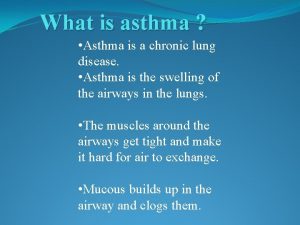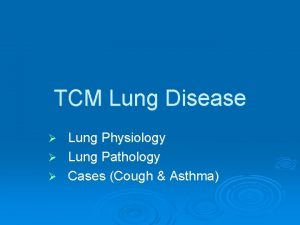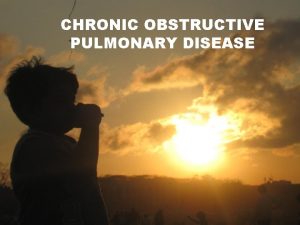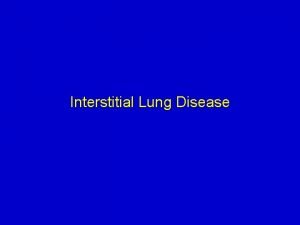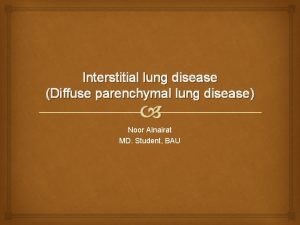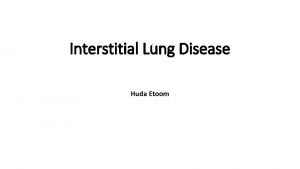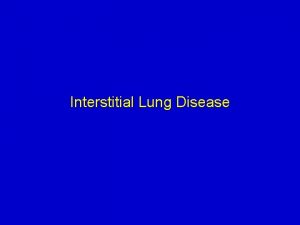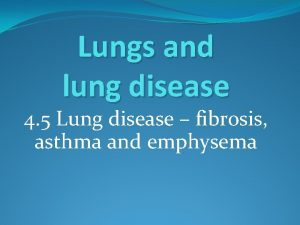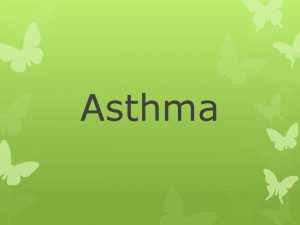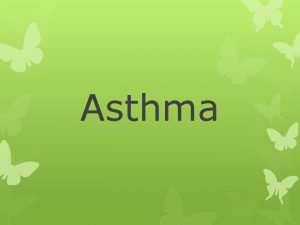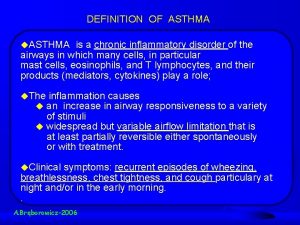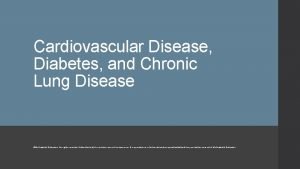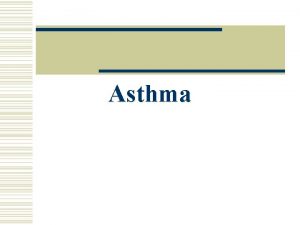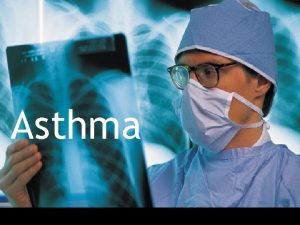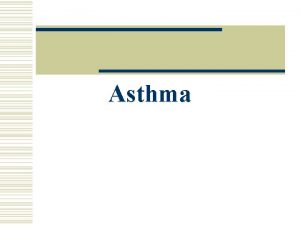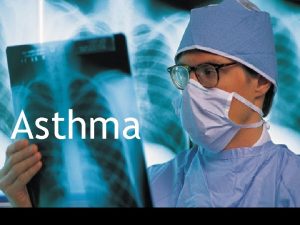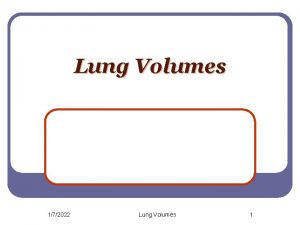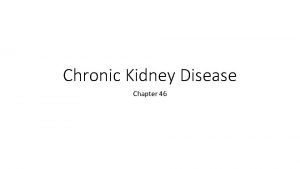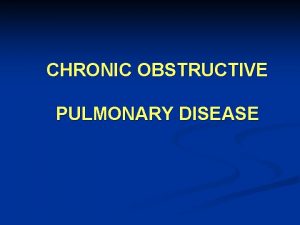ASTHMA Definition Asthma is a chronic lung disease



















































- Slides: 51


ASTHMA Definition: • Asthma is a chronic lung disease due to inflammation of the airways resulted into airway obstruction. The obstruction is reversible. • Asthma is the most common chronic disease particularly among children. Symptom: • • Wheeze Tightness in the chest Shortness of breath Sometimes nocturnal symptoms

Pathology of Asthma Inflammation Airway Hyper-responsiveness Airway Obstruction Symptoms of Asthma

ASTHMA

Asthma Increasing rates • Asthma rates have been increasing worldwide for both adults and children, males and females and in different race and ethnicities. • It is estimated that the number of people with asthma worldwide will increase by 25% in the next 15 years.

Child and Adult Asthma Prevalence United States, 1980 -2007 • Child Lifetime § Adult Current 12 -Month Source: National Health Interview Survey; CDC National Center for Health Statistics

Asthma Prevalence by Sex United States, 1980 -2007 • Female § Male Lifetime 12 -Month Current Source: National Health Interview Survey; CDC National Center for Health Statistics

ASTHMA Causes: • • Genetic Atopy Childhood respiratory infections Exposure to allergens

ASTHMA Asthma Triggers: Types of substance Air pollutants Pollen Animal dander Medication Food Example Tobacco smoke, perfumes, wood dusts, gases, chemicals, solvents, paints Trees, flowers, weeds, plants Birds, cats, dogs Aspirin, anti-inflammatory drugs, B-blockers Eggs, nuts, wheat

ASTHMA MANIFESTATION OF SEVERE ASTHMA History - Frequent use of inhaler - Previous ICU admission - Patient on steroid - Not responding to initial inhalation therapy

ASTHMA SEVERE ASTHMA: Physical Examination - HR > 115/min - RR > 30/min - Pulsus paradoxus > 10 mm. Hg - Unable to speak - Cyanosis - Silent chest

Asthma Spirometer

Asthma Arterial Blood Gases Acideamia Hypoxiamia Hypercarpia

FVC 100 75 FEV 1 NORMAL = 50 FVC > 75% 25 0 1 2 3 4 5 TIME 6 7 8

FVC 100 75 FEV 1 Airway FEV 1 Obstruction = FVC 50 < 75% 25 0 1 2 3 4 5 TIME 6 7 8

ASTHMA Poorly controlled asthma leads to: • • • Increased visits to doctors, hospital ER Hospitalizations Limitation in daily activities Lost work days Lower quality of life Death

ASTHMA Treatment: Patient/Doctor Relationship - Educate continually - Include the family - Provide information about asthma - Provide training in self-management skills

ASTHMA Treatment: Exposure Risk • Reduce exposure to indoor allergens • Avoid tobacco smoke • Avoid vehicle emission • Identify irritants in the workplace

ASTHMA Treatment • Takes daily over long period of time • Used to reduced inflammation, relaxed airway muscles and improve symptoms and lung function - Inhaled corticosteroids - Long-acting beta 2 -agonists - Leukotrienes modifiers

Asthma Quick Reliever • Used in acute attacks • Short acting beta 2 - agonists • Begins to work immediately and peaks at 5 -10 minutes

Asthma Inhalers and Spacers can help patients who have difficulty with inhaler use and can reduce potential for adverse effects from medication.

Asthma Nebulizers • Machine produces a mist of medication • Used for small children or for severe asthma • No evidence that it is more effective than an inhaler used with spacers

Asthma Anti- Ig E • For treatment of moderate to severe allergic asthma • For treatment of those who do not respond to high dose of corticosteroids

ASTHMA Treatment of Acute Attack of Asthma: - O 2 Supplementation - Inhaled Ventolin -Inhaled steroids - Inhaled Atrovent - IV Steroids For severe cases consider: - IV Mg SO 4 - Bi. PAP - Mechanical Ventilation – for those who do not respond the above treatments.


Chronic Obstructive Pulmonary Disease (COPD) • • • Limitation of expiratory flow Chronic progressive disease Associated with airway inflammation Generally irreversible airflow obstruction Related to smoking

Chronic Obstructive Pulmonary Disease (COPD) • Emphysema • Chronic bronchitis • Small airway disease

COPD Facts: • COPD is the 4 th leading cause of death in the United States • COPD has higher mortality rate than asthma • Leading cause of hospitalization in the US • 2 nd leading cause of disability

COPD Risk Factors • Smoking: most common cause • Environmental exposure - chemicals. Dust, fumes - second hand smoke • Alpha-1 anti-trypsin (AAT) deficiency

Chronic Obstructive Pulmonary Disease (COPD)

COPD Alpha 1 Anti-Trypsin (AAT) - is a serine protease inhibitors Inhibit neutrophil elastase which break down elastin Synthesized and secreted by hepatocytes Pi. ZZ phenotype is associated with low plasma concentration of AAT i. e. associated with development of emphysema

Emphysema

Emphysema

Emphysema

Emphysema

Emphysema

Emphysema

COPD Clinical Picture • Dyspnea-progressive • Cough with or without expectoration • Wheezing • Loss of weight • Hypercapnia>changes in central nervous system • Barrel chest

COPD

Chronic Bronchitis Definition • Cough for 3 months in a year for 2 consecutive year

Chronic Bronchitis

Chronic Bronchitis

COPD Treatment • • Inhalers (bronchodilators) Anti-inflammatory medications Anti-cholinergic Theophylline therapy Oxygen therapy Antibiotics Pulmonary rehabilitation Lifestyle changes - give up smoking • Bi. PAP Therapy for severe patients

COPD

COPD Treatment • • • Ventolin nebulization Steroid inhalation Atrovent inhalation Systemic steroid Non-invasive mechanical ventilation if the above measures were not effective.

COPD Home Oxygen Therapy

COPD Oxygen therapy For COPD with severe hypoxemia - It improves survival - It improves quality of life - Indicated in patient with Pa. O 2 < 60 mm. Hg

COPD Non-invasive Mechanical Ventilation Treatment

COPD Rehabilitation program - Decreased symptoms - Decreased anxiety an depression improved quality of life - Decreased hospitalization - Increase exercise capacity

Changes in FEV with Aging ( Smoker vs Non-Smoker) 1

 Cardiac asthma vs bronchial asthma
Cardiac asthma vs bronchial asthma Chronic granulomatous disease
Chronic granulomatous disease Stigmata of chronic liver disease
Stigmata of chronic liver disease Jewish chronic disease hospital study pdf
Jewish chronic disease hospital study pdf Chronic kidney disease near atwater
Chronic kidney disease near atwater Cld chronic liver disease
Cld chronic liver disease Nih scale
Nih scale Peripheral stigmata of cld
Peripheral stigmata of cld Nonalcoholic fatty liver disease
Nonalcoholic fatty liver disease Kate lorig chronic disease self-management
Kate lorig chronic disease self-management Developed by ed
Developed by ed Chronic disease
Chronic disease Defination of liver
Defination of liver Chronic disease
Chronic disease Copd disease
Copd disease Vijaya's echo criteria
Vijaya's echo criteria Farmer's lung disease
Farmer's lung disease Uip
Uip Restrictive lung disease
Restrictive lung disease Restrictive lung disease
Restrictive lung disease Obstructive vs restrictive
Obstructive vs restrictive Dpld
Dpld Difference between restrictive and obstructive lung disease
Difference between restrictive and obstructive lung disease Gross lungs
Gross lungs Difference between obstructive and restrictive lung disease
Difference between obstructive and restrictive lung disease Lung disease
Lung disease Bharathi viswanathan
Bharathi viswanathan Definition of chronic toxicity
Definition of chronic toxicity Chronic care model definition
Chronic care model definition Definition of chronic toxicity
Definition of chronic toxicity Chronic pain definition
Chronic pain definition Inspiratory wheeze
Inspiratory wheeze Spirogram diagram
Spirogram diagram Angioectasia icd 10
Angioectasia icd 10 The flinders model
The flinders model Earthy look in chronic renal failure
Earthy look in chronic renal failure Periapical granuloma vs abscess
Periapical granuloma vs abscess Hematocrit measures
Hematocrit measures Pathogenesis of cholecystitis
Pathogenesis of cholecystitis Fibromyalgia vs chronic fatigue
Fibromyalgia vs chronic fatigue Chronic ulcerative pulpitis
Chronic ulcerative pulpitis Acute inflammation definition
Acute inflammation definition Iceberg phenomenon definition
Iceberg phenomenon definition Evidence of hemolysis
Evidence of hemolysis Chronic unease in the workplace
Chronic unease in the workplace Pathophysiology of cholelithiasis ppt
Pathophysiology of cholelithiasis ppt Chronic blood loss
Chronic blood loss Acute cholecystitis vs chronic cholecystitis
Acute cholecystitis vs chronic cholecystitis Acute subacute chronic
Acute subacute chronic Hyperplasia
Hyperplasia Basic & clinical pharmacology
Basic & clinical pharmacology Chronic blood loss
Chronic blood loss

